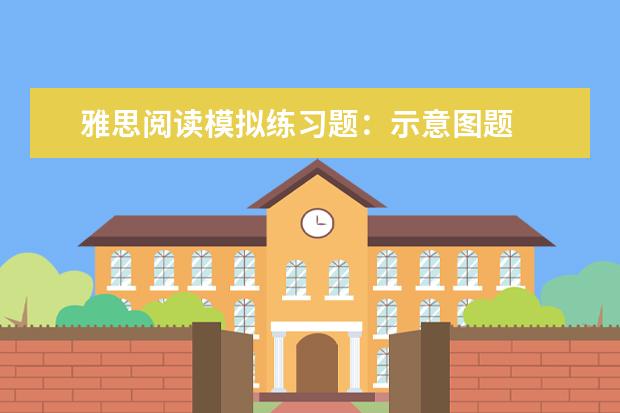雅思阅读题专项练习 雅思阅读模拟练习题:段落标题题。相关内容,小编在这里做了整理,希望能对大家有所帮助,关于雅思阅读题专项练习 雅思阅读模拟练习题:段落标题题。信息,一起来了解一下吧!

雅思阅读模拟练习题:段落标题题。
您好,我是专注留学考试规划和留学咨询的小钟老师。在追寻留学梦想的路上,选择合适的学校和专业,准备相关考试,都可能让人感到迷茫和困扰。作为一名有经验的留学顾问,我在此为您提供全方位的专业咨询和指导。欢迎随时提问!
想要提升雅思阅读的成绩,那么想要同学们平时有没有做一些习题来提升自己的雅思阅读做题能力呢?今天就和小钟老师来看看雅思阅读模拟练习题:段落标题题。
雅思阅读模拟练习题:段落标题题
Persistent bullying is one of the worst experiences a child can face. How can it be prevented? Peter Smith, Professor of Psychology at the University of Sheffield, directed the Sheffield
Anti-Bullying Intervention Project, funded by the Department for Education. Here he reports on his findings.
A
Bullying can take a variety of forms, from the verbal - being taunted or called hurtful names - to the physical - being kicked or shoved - as well as indirect forms, such as being excluded from social groups. A survey I conducted with Irene Whitney found that in British primary schools up to a quarter of pupils reported experience of bullying, which in about one in ten cases was persistent. There was less bullying in secondary schools, with about one in twenty-five suffering persistent bullying, but these cases may be particularly recalcitrant.
B
Bullying is clearly unpleasant, and can make the child experiencing it feel unworthy and depressed. In extreme cases it can even lead to *, though this is thankfully rare. Victimised pupils are more likely to experience difficulties with interpersonal relationships as *s, while children who persistently bully are more likely to grow up to be physically violent, and convicted of anti-social offences.
C
Until recently, not much was known about the topic, and little help was available to teachers to deal with bullying. Perhaps as a consequence, schools would often deny the problem. 'There is no bullying at this school' has been a common refrain, almost certainly untrue. Fortunately more schools are now saying: 'There is not much bullying here, but when it occurs we have a clear policy for dealing with it.”
D
Three factors are involved in this change. First is an awareness of the severity of the problem. Second, a number of resources to help tackle bullying have become available in Britain. For example, the Scottish Council for Research in Education produced a package of materials, Action Against Bullying, circulated to all schools in England and Wales as well as in Scotland in summer 1992, with a second pack, Supporting Schools Against Bullying, produced the following year. In Ireland, Guidelines on Countering Bullying Behaviour in Post-Primary Schools was published in 1993. Third, there is evidence that these materials work, and that schools can achieve something. This comes from carefully conducted 'before and after' evaluations of interventions in schools, monitored by a research team. In Norway, after an intervention campaign was introduced nationally, an evaluation of forty-two schools suggested that, over a two-year period, bullying was halved. The Sheffield investigation, which involved sixteen primary schools and seven secondary schools, found that most schools succeeded in reducing bullying.
E
Evidence suggests that a key step is to develop a policy on bullying, saying clearly what is meant by bullying, and giving explicit guidelines on what will be done if it occurs, what records will be kept, who will be informed, what sanctions will be employed. The policy should be developed through consultation, over a period of time—not just imposed from the head teacher's office! Pupils, parents and staff should feel they have been involved in the policy, which needs to be disseminated and implemented effectively.
Other actions can be taken to back up the policy. There are ways of dealing with the topic through the curriculum, using video, drama and literature. These are useful for raising awareness, and can best be tied in to early phases of development, while the school is starting to discuss the issue of bullying. They are also useful in renewing the policy for new pupils, or revising it in the light of experience. But curriculum work alone may only have short-term effects; it should be an addition to policy work, not a substitute.
There are also ways of working with individual pupils, or in *all groups. Assertiveness training for pupils who are liable to be victims is worthwhile, and certain approaches to group bullying such as 'no blame', can be useful in changing the behaviour of bullying pupils without confronting them directly, although other sanctions may be needed for those who continue with persistent bullying.
Work in the playground is important, too. One helpful step is to train lunchtime supervisors to distinguish bullying from playful fighting, and help them break up conflicts. Another possibility is to improve the playground environment, so that pupils are less/likely to be led into bullying from boredom or frustration.
F
With these developments, schools can expect that at least the most serious kinds of bullying can largely be prevented. The more effort put in and the wider the whole school involvement, the more substantial the results are likely to be. The reduction in bullying—and the consequent improvement in pupil happiness—is surely a worthwhile objective.
希望以上的答复能对您的留学申请有所帮助。如果您有任何更详细的问题或需要进一步的协助,我强烈推荐您访问我们的留学官方网站
,在那里您可以找到更多专业的留学考试规划和留学资料以及*的咨询服务。祝您留学申请顺利!
2023年雅思阅读考试精选习题及答案(3)
您好,我是专注留学考试规划和留学咨询的小钟老师。在追寻留学梦想的路上,选择合适的学校和专业,准备相关考试,都可能让人感到迷茫和困扰。作为一名有经验的留学顾问,我在此为您提供全方位的专业咨询和指导。欢迎随时提问!
小钟老师为大家带来2023年雅思阅读考试精选习题及答案(3),欢迎大家参考!更多相关内容请关注本站!
2023年雅思阅读考试精选习题及答案(3)
Talc Powder
A Peter Brigg discovers how talc from Luzenac's Trimouns in France find its way into food and agricultural products - from chewing gum to olive oil. High in the French Pyrenees, some 1,700m above sea level, lies Trimouns, a huge deposit of hydrated magnesium silicate - talc to you and me. Talc from Trimouns, and from ten other Luzenac mines across the globe, is used in the manufacture of a vast array of everyday products extending from paper, paint and plaster to co*etics, plastics and car tyres. And of course there is always talc's best known end use: talcum powder for babies1 bottoms. But the true versatility of this remarkable mineral is nowhere better displayed than in its sometimes surprising use in certain niche markets in the food and agriculture industries.
B Take, for example, the chewing gum business. Every year, Talc de Luzenac France - which owns and operates the Trimouns mine and is a member of the international Luzenac Group (art of Rio Tinto minerals) supplies about 6,000 tones of talc to chewing gum manufacturers in Europe. "We've been selling to this sector of the market since the 1960s," says Laurent Fournier, sales manager in Luzenac's Specialties business unit in Toulouse. "Admittedly, in terms of our total annual sales of talc, the amount we supply to chewing gum manufacturers is relatively *all, but we see it as a valuable niche market: one where customers place a premium on securing supplies from a reliable, high quality source. Because of this, long term allegiance to a proven suppler is very much a feature of this sector of die talc market." Switching sources - in the way that you might choose to buy, say, paperclips from Supplier A rather than from Supplier B - is not an easy option for chewing gum manufacturers." Fournier says. "The cost of reformulating is high, so when customers are using a talc grade that works, even if it's expensive, they are understandably reluctant to switch."
C But how is talc actually used in the manufacture of chewing gum? Patrick Delord, an engineer with a degree in agronomics, who has been with Luzenac for 22 years and is now senior market development manager, Agriculture and Food, in Europe, explains that chewing gums has four main components. "The most important of them is the gum base," he says. "It's the gum base that puts the chew into chewing gum. It binds all the ingredients together, creating a soft, *ooth texture. To this the manufacturer then adds sweeteners, softeners and flavourings. Our talc is used as a filler in the gum base. The amount vanes between, say, ten and 35 per cent, depending on the type of gum. Fruit flavoured chewing gum, for example, is slightly acidic and would react with the calcium carbonate that the manufacturer might otherwise use as a filler. Talc, on the other hand, makes an ideal filler because it's non-reactive chemically. In the factory, talc is also used to dust the gum base pellets and to stop the chewing gum sticking during the lamination and packing process," Delord adds.
D The chewing gum business is, however, just one example of talc's use in the food sector. For the past 20 years or so, olive oil processors in Spain have been taking advantage of talc's unique characteristics to help them boost the amount of oil they extract from crushed olives According to Patrick Delord, talc is especially useful for treating what he calls "difficult" olives. After the olives are harvested - preferably early in the morning because their taste is better if they are gathered in the cool of the day they are taken to the processing plant. There they arc crushed and then stirred for 30-45 minutes. In the old days, the resulting paste was passed through an olive press but nowadays it's more common to add water and (K-6IH) the mixture to separate the water and oil from the solid matter The oil and water are then allowed to settle so that the olive oil layer can be )and bottled. “Difficult” olives are those that are more reluctant than the norm to yield up their full oil content. This may be attributable to the particular species of olive, or to its water content and the time of year the olives arc collected - at the beginning and the end of the season their water content is often either too high or too low. These olives are easy to recognize because they produce a lot of extra foam during the stirring process, a consequence of an excess of a fine solid that acts as a natural emulsifier. The oil in this emulsion is lost when the water is disposed of. Not only that, if the waste water is disposed of directly into local fields - often the case in many *aller processing operations - the emulsified oil may take some time to biodegrade and so be harmful to the environment.
E "If you add between a half and two percent of talc by weight during the stirring process, it absorbs the natural emulsifier in the olives and so boosts the amount of oil you can extract," says Delord. "In addition, talc's flat, 'platey' structure helps increase the size of the oil droplets liberated during stirring, which again improves the yield. However, because talc is chemically inert, it doesn't affect the color, taste, appearance or composition of the resulting olive oil."
F If the use of talc in olive oil processing and in chewing gum is long established, new applications in the food and agriculture industries arc also constantly being sought by Luzenac. One such promising new market is fruit crop protection, being pioneered in the US. Just like people, fruit can get sunburned. In fact, in very sunny regions up to 45 per cent of a typical crop can be affected by heat stress and sunburn However, in the case of fruit, it's not so much the ultra violet rays which harm the crop as the high surface temperature that the sun's rays create.
G To combat this, farmers normally use either chemicals or spray a continuous fine canopy of mist above the fruit frees or bushes. The trouble is, this uses a lot of water - normally a precious commodity in hot, sunny areas - and it is therefore expensive. What's more, the ground can quickly become waterlogged. "So our idea was to coat the fruit with talc to protect it from the sun," says Greg Hunter, a marketing specialist who has been with Luzenac for ten years. "But to do this, several technical challenges had first to be overcome. Talc is very hydrophobic: it doesn't like water. So in order to have a viable product we needed a wettable powder - something that would go readily into suspension so that it could be sprayed onto the fruit. It also had to break the surface tension of the cutin (the natural waxy, waterproof layer on the fruit) and of course it had to wash off easily when the fruit was harvested. No-one's going to want an apple that's covered in talc."
H Initial trials in the state of Washington in 2023 showed that when the product was sprayed onto Granny Smith apples, it reduced their surface temperature and lowered the incidence of sunburn by up to 60 per cent. Today the new product, known as Invelop Maximum SPF, is in its second commercial year on the US market. Apple growers are the primary target although Hunter believes grape growers represent another sector with long term potential. He is also hopeful of extending sales to overseas markets such as Australia, South America and southern Europe.
希望以上的答复能对您的留学申请有所帮助。如果您有任何更详细的问题或需要进一步的协助,我强烈推荐您访问我们的留学官方网站
,在那里您可以找到更多专业的留学考试规划和留学资料以及*的咨询服务。祝您留学申请顺利!
雅思阅读真题训练
TIME: 5-7'
HOW IQ BECOMES IQ
In 1904 the French minister of education, facing limited resources for schooling, sought a way to separate the unable from the merely lazy. Alfred Binet got the job of devising selection principles and his brilliant solution put a stamp on the study of intelligence and was the forerunner of intelligence tests still used today. He developed a thirty-problem test in 1905, which tapped several abilities related to intellect, such as judgment and reasoning. The test determined a given child's mental age'. The test previously established a norm for children of a given physical age. For example, five-year-olds on average get ten items correct, therefore, a child with a mental age of five should score 10, which would mean that he or she was functioning pretty much as others of that age. The child's mental age was then compared to his physical age.
A large disparity in the wrong direction (e.g., a child of nine with a mental age of four) might suggest inability rather than laziness and means that he or she was earmarked for special schooling. Binet, however, denied that the test was measuring intelligence and said that its purpose was simply diagnostic, for selection only. This message was however lost and caused many problems and misunderstandings later.
Although Binet's test was popular, it was a bit inconvenient to deal with a variety of physical and mental ages. So, in 1912, Wilhelm Stern suggested simplifying this by reducing the two to a single number. He divided the mental age by the physical age and multiplied the result by 100. An average child, irrespective of age, would score 100. a number much lower than 100 would suggest the need for help and one much higher would suggest a child well ahead of his peer.
This measurement is what is now termed the IQ (intelligence quotient) score and it has evolved to be used to show how a person, * or child, performed in relation to others. The term IQ was coined by Lewis m. Terman, professor of psychology and education of Stanford University, in 1916. He had constructed an enormously influential revision of Binet's test, called the Stanford-Binet test, versions of which are still given extensively.
The field studying intelligence and developing tests eventually coalesced into a sub-field of psychology called psychometrics (psycho for ‘mind' and metrics for 'measurements'). The practical side of psychometrics (the development and use of tests) became widespread quite early, by 1917, when Einstein published his grand theory of relativity, mass-scale testing was already in use.
Germany's unrestricted submarine warfare (which led to the sinking of the Lusitania in 1915) provoked the United States to finally enter the first world war in the same year. The military had to build up an army very quickly and it had two million inductees to sort out. Who would become officers and who enlisted men? Psychometricians developed two intelligence tests that helped sort all these people out, at least to some extent. This was the first major use of testing to decide who lived and who died since officers were a lot safer on the battlefield. The tests themselves were given under horrendously bad conditions and the examiners seemed to lack common sense. A lot of recruits simply had no idea what to do and in several sessions most inductees scored zero! The examiners also came up with the quite astounding conclusion from the testing that the average American *'s intelligence was equal to that of a thirteen-year-old!
Nevertheless, the ability for various authorities to classify people on scientifically justifiable premises was too convenient and significant to be di*issed lightly, so with all good astounding intentions and often over enthusia*, society's affinity for psychological testing proliferated.
Back in Europe, Sir Cyril Burt, professor of psychology at University College London from 1931 to 1950, was a prominent figure for his contribution to the field. He was a firm advocate of intelligence testing and his ideas fitted in well with English cultural ideas of eliti*. A government committee in 1943 used some of Burt's ideas in devising a rather primitive typology on children's intellectual behavior. All were tested at age eleven and the top 15 or 20 per cent went to grammar schools with good teachers and a fast pace of work to prepare for the few university places available. A lot of very bright working-class children, who otherwise would never have succeeded, made it to grammar schools and universities.
The system for the rest was however disastrous. These children attended lesser secondary or technical schools and faced the prospect of eventual education oblivion. They felt like dumb failures, which having been officially and scientifically branded. No wonder their motivation to study plummeted. It was not until 1974 that the public education system was finally reformed. Nowadays it is believed that Burt has fabricated a lot of his data. Having an obsession that intelligence is largely genetic, he apparently made up twin studies, which supported this idea, at the same time inventing two co-workers who were supposed to have gathered the results.
Intelligence testing enforced political and social prejudice and their results were used to argue that Jews ought to be kept out of the United States because they were so intelligently inferior that they would pollute the racial mix. And blacks ought not to be allowed to breed at all. Abuse and test bias controversies continued to plaque psychometrics.
Measurement is fundamental to science and technology. Science often advances in leaps and bounds when measurement devices improve. Psychometrics has long tried to develop ways to gauge psychological qualities such as intelligence and more specific abilities, anxiety, extroversion, emotional stability, compatibility with marriage partner and so on. Their scores are often given enormous weight. A single IQ measurement can take on a life of its own if teachers and parents see it as definitive. It became a major issue in the 70s when court cases were launched to stop anyone from making important decisions based on IQ test scores. the main critici* was and still is that current tests don't really measure intelligence. Whether intelligence can be measured at all is still controversial. some say it cannot while others say that IQ tests are psychology's greatest accomplishments.
以上就是雅思阅读题专项练习 雅思阅读模拟练习题:段落标题题。全部内容了,了解更多相关信息,关注雅思无忧。
雅思培训
免责声明:文章内容来自网络,如有侵权请及时联系删除。


 雅思阅读练习题:Alternative Farming Methods in Oregon
雅思阅读练习题:Alternative Farming Methods in Oregon
 雅思阅读词汇练习题精选
雅思阅读词汇练习题精选
 雅思阅读练习题 2023年5月22日雅思考试真题答案阅读部分
雅思阅读练习题 2023年5月22日雅思考试真题答案阅读部分
 雅思阅读模拟练习题 西双版纳雅思阅读真题及解析
雅思阅读模拟练习题 西双版纳雅思阅读真题及解析
 雅思阅读题练习 雅思阅读模拟练习题:段落标题题。
雅思阅读题练习 雅思阅读模拟练习题:段落标题题。
 雅思阅读题库练习 雅思(IELTS)阅读练习题:物品和生物体的区别
雅思阅读题库练习 雅思(IELTS)阅读练习题:物品和生物体的区别
 雅思阅读模拟练习题:示意图题
雅思阅读模拟练习题:示意图题
 雅思阅读练习简单题 雅思阅读模拟练习题:段落标题题。
雅思阅读练习简单题 雅思阅读模拟练习题:段落标题题。
 雅思阅读专项练习推荐 雅思阅读模拟练习题:段落标题题。
雅思阅读专项练习推荐 雅思阅读模拟练习题:段落标题题。
 雅思阅读技巧练习题 雅思阅读单选题答题技巧分享
雅思阅读技巧练习题 雅思阅读单选题答题技巧分享